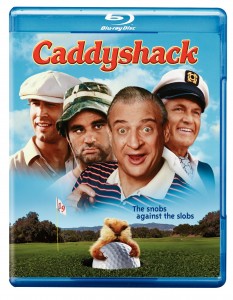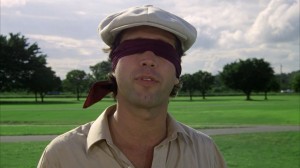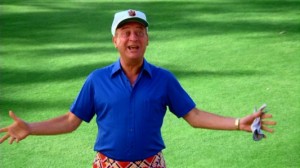It’s just over thirty years since Caddyshack graced our screens, providing us a heck of a lot of laughs and still-quotable quotes. But did you know that watching Caddyshack can also improve your golf?

As most golfers know, Caddyshack is the greatest movie in the history of movies. Not just best golf movie…not just best sports movie. Best movie, period. Released in 1980, it was Harold Ramis’ first gig as director (he would later know fame as a Ghostbuster) and stars Chevy Chase, Rodney Dangerfield and Bill Murray as a madcap greenkeeper who dreams of Augusta.
Haven’t seen it? Well, once you’ve read this magazine, get yourself a copy of this gem and watch it. And watch it again. Watch it thirty times — once for each year it’s been out.
For not only is Caddyshack nuanced, quotable and funnier on subsequent viewings, you can also learn from it. True story: Caddyshack can improve your golf. Let us count the ways:
The Dalai Lama
The Scene: Assistant Greenkeeper Carl Spackler (Bill Murray) is telling a long-winded story to a caddy, emphasising his point with the prongs of a pitchfork.
The Quote: “So I jump ship in Hong Kong and I make my way over to Tibet, and I get on as a looper at a course over there in the Himalayas. A looper, you know, a caddy, a looper, a jock. So I tell them I’m a pro jock, and who do you think they give me? The Dalai Lama, himself. Twelfth son of the Lama. The flowing robes, the grace, bald … striking. So I’m on the first tee with him. I give him the driver. He hauls off and whacks one — big hitter, the Lama, long — into a ten-thousand foot crevasse, right at the base of this glacier. And do you know what the Lama says? Gunga galunga … gunga, gunga-lagunga.”
The Lesson: Have a Plan
“Amateur golfers, particularly high handicappers, frequently play spontaneously, making up strategy on the fly,” writes Dr Bob Rotella in his seminal mental instruction manual Golf Is Not A Game of Perfect.
“A good professional never plays a tournament round without examining the course and preparing a plan to play it. The plan encompasses target and club selection for each shot, the preferred landing area on every green, and hazards to be avoided.”
“Be the ball”

The Scene: Ty Webb (Chevy Chase) blindfolds himself then hits a beautiful shot which lands near the flag. He tries to show caddy Danny Noonan how to do it.
The Quote: “Hear nothing, feel nothing… relax, find your centre, picture the shot, Danny, let it happen, and BE the ball.”
The Lesson: Develop a ‘Third Eye’
“It’s similar to Olympic shooters,” says David Niethe, Mental Performance Director at the New Zealand Institute of Golf.
“They get to a point when they’re relaxed and their focus is only on the smallest target. There’s no internal dialogue, their peripheral vision disappears and they get into ‘The Zone’. Try and achieve that as you’re standing over the ball. Focus on what you want rather than what you want to avoid.”
Adds Rotella: “Nick Price told me that once he had picked out a target he could look back to the ball, but continue to ‘see’ the target in his mind. Other good players tell me they feel almost as if they had a third eye on the left side of their head.”
“Spaulding!”
The Scene: Judge Smails is introducing his niece, Lacey Underall, to Dr Beeper and The Bishop. In the background Smails’ nephew Spaulding is attempting to tee off – without success.
The Quote: “Turds! Double turds!”
The Lesson: Develop a post-shot routine
To avoid carrying the baggage of a bad shot through to the next one, “Go through a process after you’ve hit your shot,” advises Niethe.
“Hold the pose, watch the result. The purpose is to get you back into a functional state and help preserve your self-image. You hear golfers swear after bad shots, and call themselves idiots. And it can be ongoing.”
Greg Green, a pro from Sydney’s Beverley Park, who holds a psychology degree from Georgia Southern University, says you should place equal importance on every shot that you play. “Concentrate on every shot like it’s the only shot you’re playing that day. Tigers says he tries to do it every round. For him – and Stuart Appleby said something similar after he shot 59 – the ‘perfect round’ is one that on each shot he’s had nothing on his mind but that shot.”
“Gambling is illegal at Bushwood, sir, and I never slice”
The Scene: Judge Smails is lining up a short putt and taking his time. Al Czervik approaches the green and bets him “a thousand bucks you miss”. Smails misses. Enraged, he hurls his putter towards the clubhouse where it strikes a member’s wife. There is conflict. Danny Noonan helps Smails with the disagreement.
The Quote: “I noticed your grips were worn, sir, it’s my fault.”
The Lesson: Grip pressure
To find out the pressure, “grip the club so lightly that it slides out,” says Institute of Golf instructor Craig Dixon. “Call that grip pressure 1. Then squeeze it as hard as you can. That’s a five. For short game shots you want about 2.5 grip pressure. Full swing, go with a three.” To keep your grips in good order, Dixon advises washing them in soapy water, scrubbing vigorously and drying with a towel.
“At Augusta”
The Scene: Carl is whacking the heads off flowers with a garden tool, commentating to himself that he’s “at Augusta”.
The Quote: “Here he is, Cinderella boy, tears in his eyes, I guess. About to become, the Masters champion. [Whack]. Oh! He got onto that. It’s a mirac- it’s in the hole! It’s in the hole!”
The Lesson: Practise like you’re playing
“On the driving range, pretend you’re playing a round at your home course,” advises Green.
“If it’s a par-5, hit the driver. If you slice it, next take the club you would from the right rough. If you hit it straight, take a 3-wood (or whatever). Get ‘close’ and hit wedge. Practise your technique on the range, and then on the course just play. There’s too many other things to think about when you’re playing.”
Niethe advises you spend the last ten per cent of your practice time hitting balls with your pre- and post-shot routines.
“The last thing you take away from the range is what you take to the course.”
On the practice green, try to simulate pressure.
“Take ten balls and place them a putter’s length all around the hole,” says Green. “And then try to sink them all in a row. If you miss one, start again. The pressure rises as you get closer to ten. It’s the only one I ever used as a touring pro.”
The Storm
The Scene: The Bishop is playing the best round of his life in a raging, cyclonic lightning storm that becomes ever fiercer. His advisor and caddy is greenkeeper Carl.
The Quote: “I’d keep playing. I don’t think the heavy stuff is going to come down for quite a while.”
The Lesson: Be prepared
“In the wind, watch your tempo. Players try to hit the ball harder and it puts more spin on the ball which sends it up in the air. Take an extra club and swing easily. This should lower ball flight.”
In the rain, stick to routine, says Green.
“For serious golfers I’d recommend they practice in the rain; that way there aren’t any curveballs coming your way.” But, Dixon warns: “Don’t play in the lightning!”.
Playing Through
The Scene: Ty hits a ball through a window of Carl’s shack. He goes in to retrieve his ball and asks if he can play through. While there, they drink and talk about the upcoming bet against Judge Smails.
The Quote: “What you got to do with Smails is, you cut the hamstring on the back of his leg, right at the bottom. He’ll never play golf again. Because he goes back, his weight displacement goes back, and he stays there, all his weight’s on his right foot and he’s pushing everything off to the right. He’ll never come through on anything. He’ll quit the game.”
The Lesson: Finish with your weight on the foot nearest the hole
“To improve weight transfer, lift your feet as you take a practice swing,” says Green.
“[For right-handers] lift your left foot as you go back. As you swing through, lift your right. But someone who gets stuck on their back foot, typically something else needs to be fixed. It’s cause and effect. Maybe their hip flexors are too tight. It’s individual, there’s not a blanket answer. See a pro.”
The Party

The Scene: After the gopher holes explode in mushroom clouds across Bushwood Country Club, and with the competition/bet finished, Al Czervik sends his goons away to get money out of Judge Smails. Al turns to a large gathering of people and exclaims that a “celebration” is in order (that’s our G-rated explanation, anyway.)
The Lesson: Perspective
“After your round, make sure you let go of the negative emotion and preserve the learning,” says Niethe.
“Debrief post-round and think about what you can learn. People have an expectation that they’ll play to their handicap, but handicap is only an indication of what you’re capable of. And we’re not all professionals.”
Try explaining that to Carl Spackler.




![Win the golfing experience of a lifetime, at the Hawai‘i International Week of Golf, valued at $6,900 [Winner Announced] Win the golfing experience of a lifetime, at the Hawai‘i International Week of Golf, valued at $6,900 [Winner Announced]](https://www.insidegolf.com.au/wp-content/uploads/Hawaii-Comp-500x294.jpg)
One Response to "BE the ball: How watching Caddyshack can improve your golf"